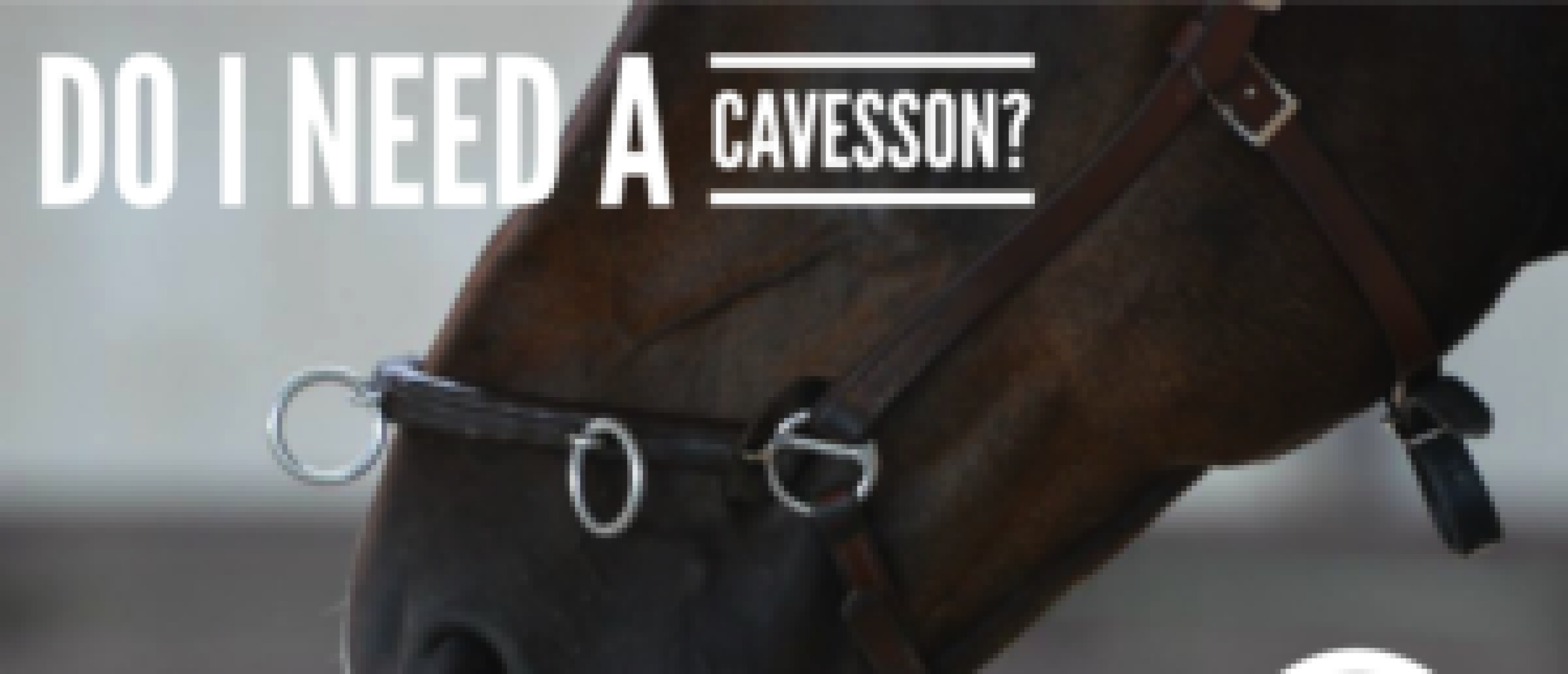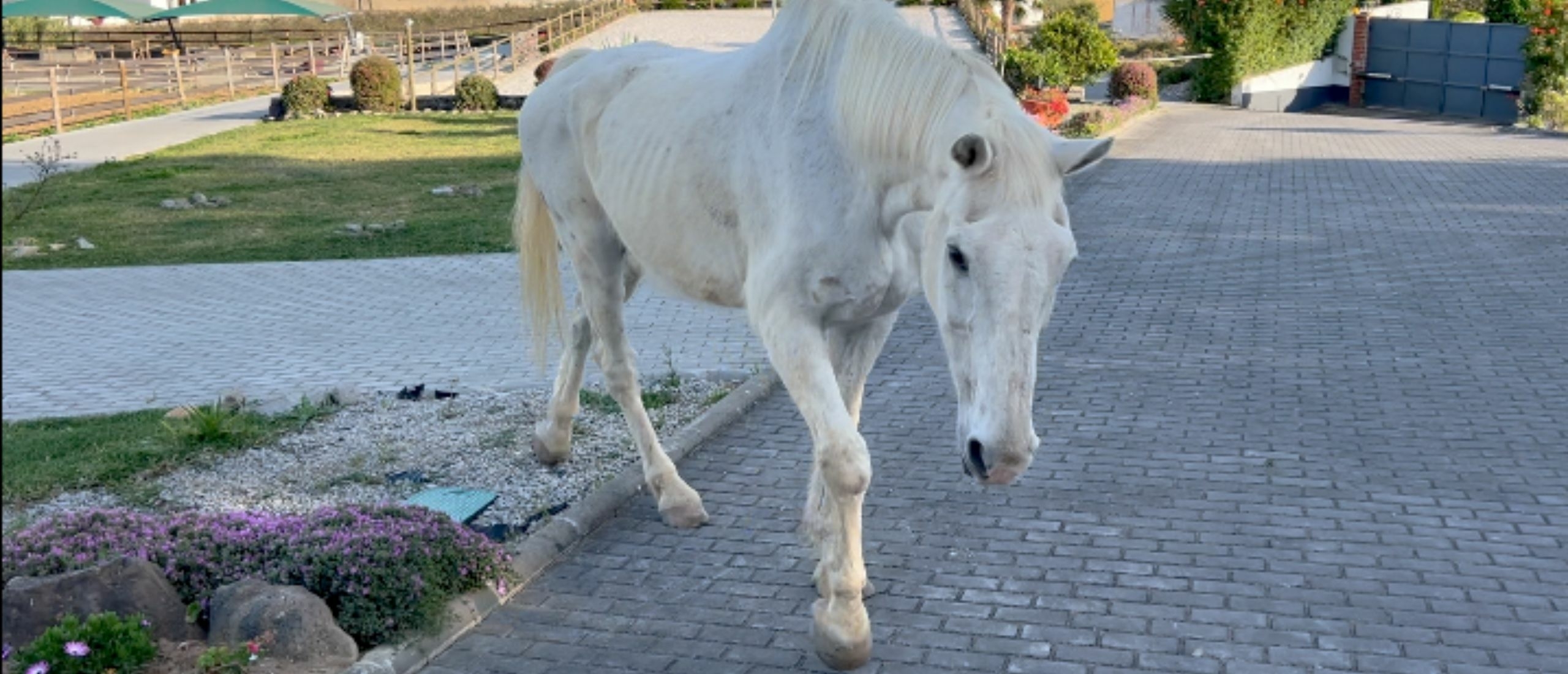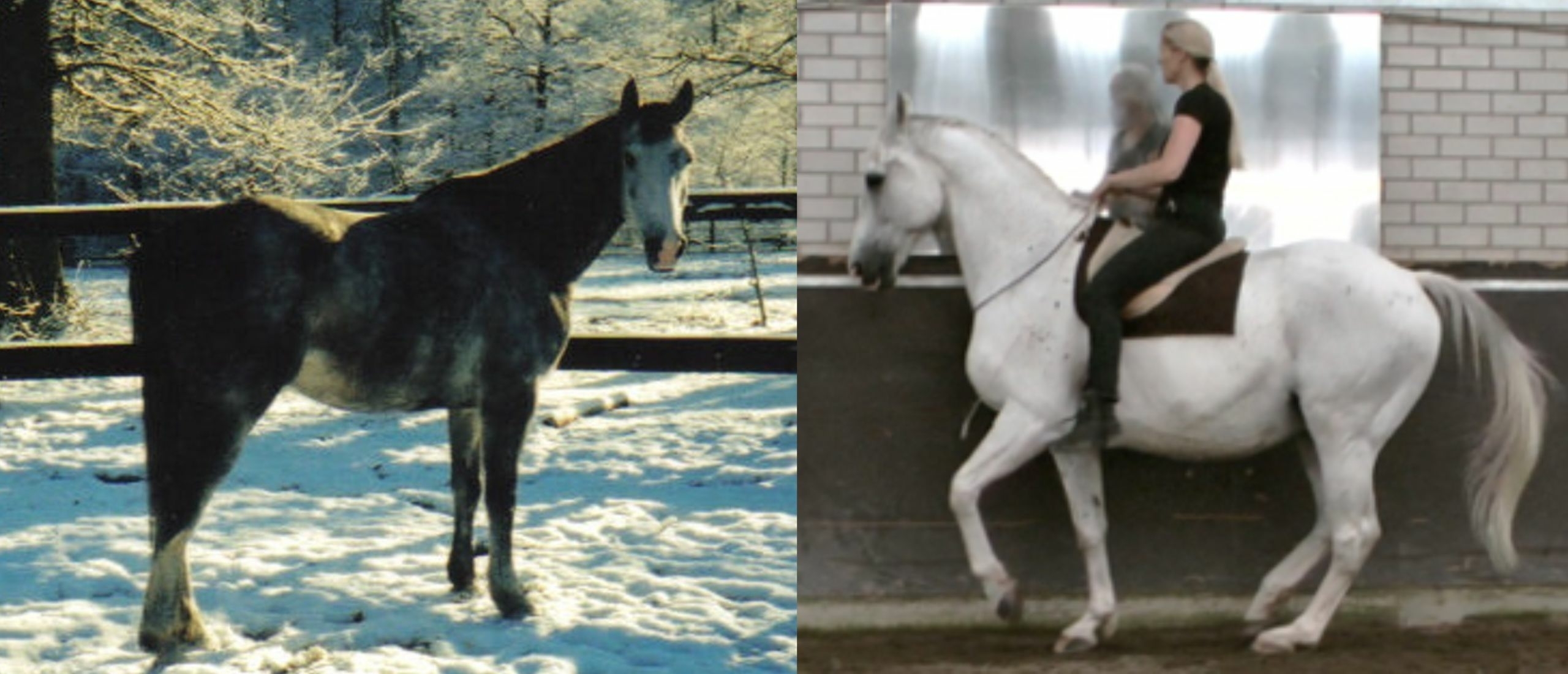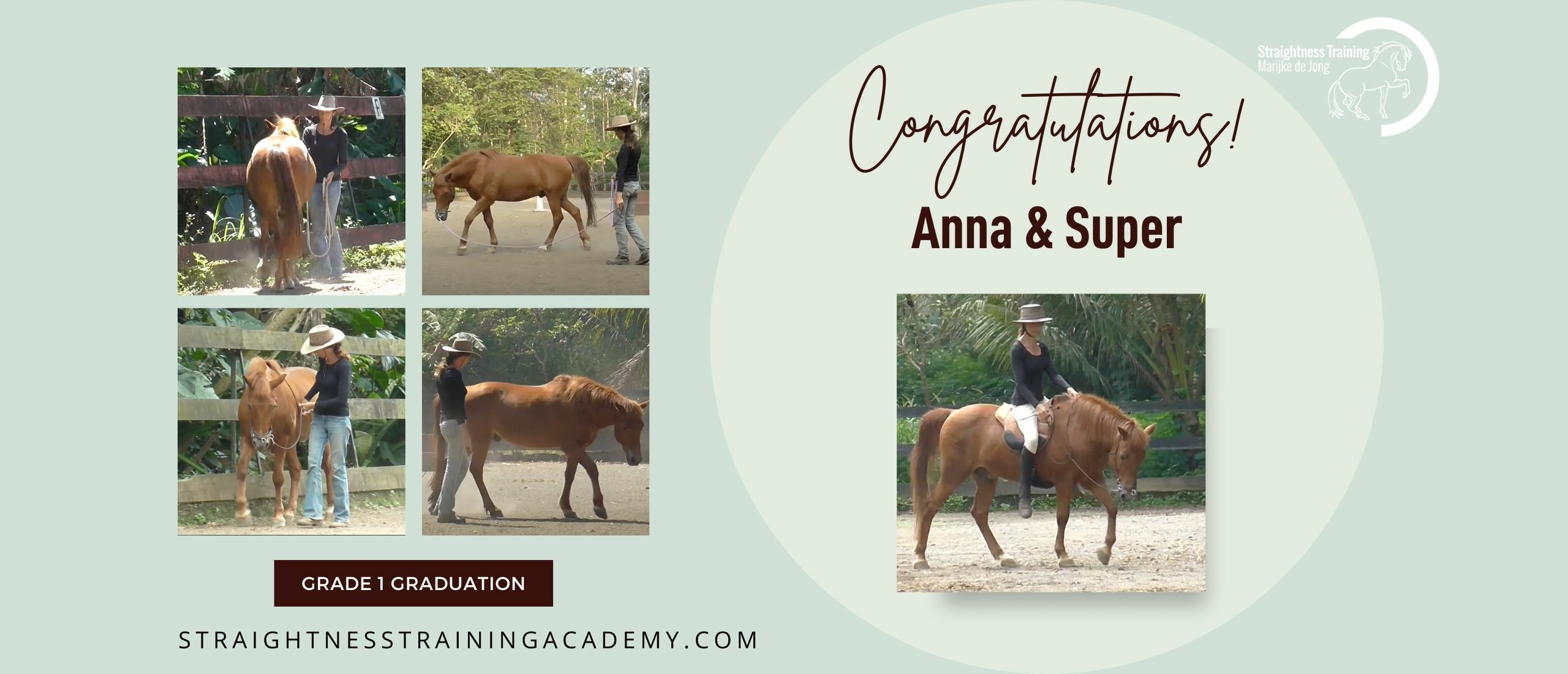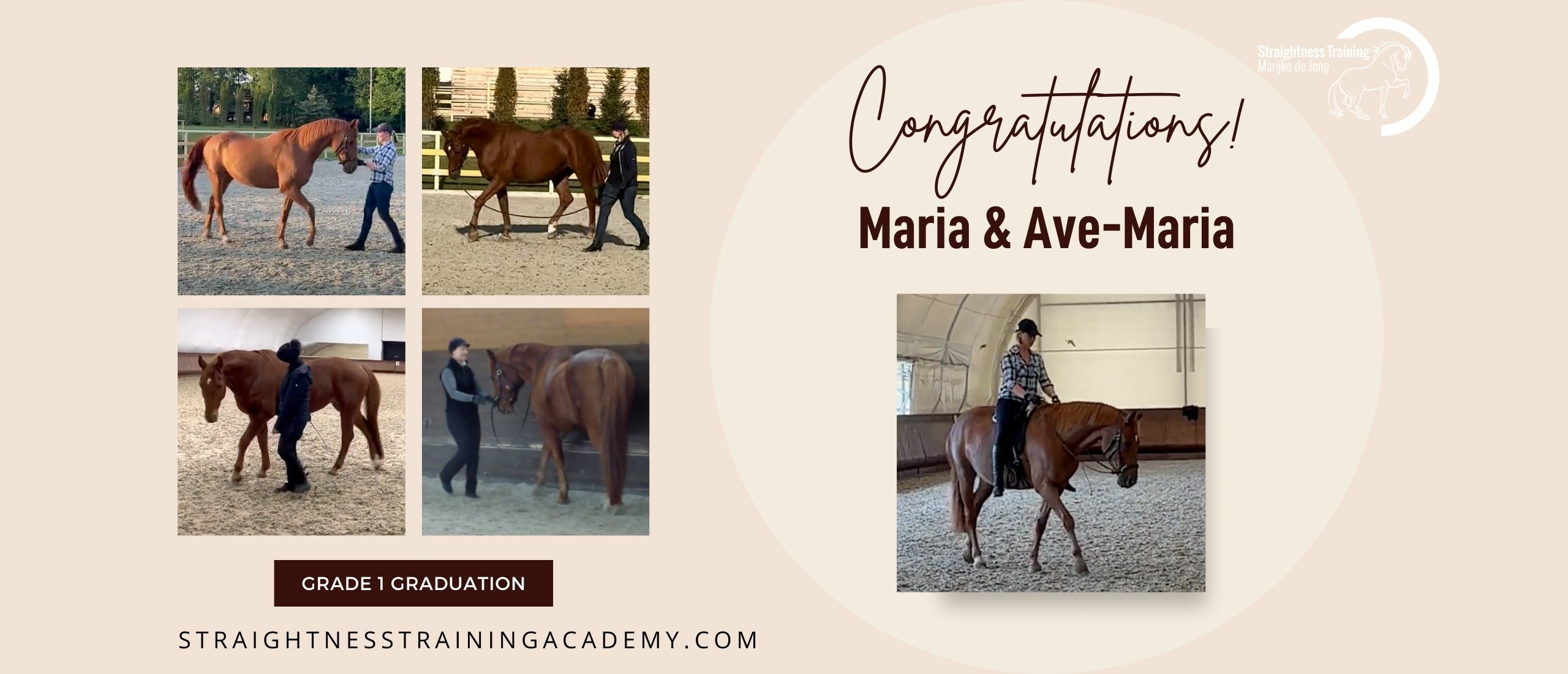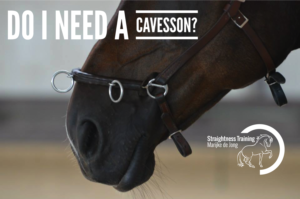 Before we dive into this question, let's speak about the use of tools in general first:
Before we dive into this question, let's speak about the use of tools in general first:
1. Benefits
The benefits of using tack, tools and equipment is, that we can enhance our ways to communicate with the horse, so we can help him the best we can in getting symmetrical in body and limbs. Of course this is only if the tack is used correctly. If a tool is used incorrectly, it will harm the relationship with your horse. A tool is used incorrectly, when it's used with too much pressure, too long pressure, when there's lack of release, when too often pressure is used, or when the trainer doesn't master his energy well. Incorrect use of any tool can harm the communication and the relationship with the horse.  Now a tool itself is never the problem; when not touched by a human, the tool will not say or do anything to the horse. So it's never the tool, it's always the human behind the tool. And the refinement of detailed communication is always defined by the rider's hand, and not by the rider's tool! Now let's say the human knows how to use a tool correctly, then there are many options a human can choose when it comes to practicing ST. And the most important question is not WHAT tool we should use, but WHY we should choose a certain tool.
Now a tool itself is never the problem; when not touched by a human, the tool will not say or do anything to the horse. So it's never the tool, it's always the human behind the tool. And the refinement of detailed communication is always defined by the rider's hand, and not by the rider's tool! Now let's say the human knows how to use a tool correctly, then there are many options a human can choose when it comes to practicing ST. And the most important question is not WHAT tool we should use, but WHY we should choose a certain tool.
2. Purpose
The goal of Straightness Training (ST) is to straighten horses. And with that, we mean that we would like to develop the horse symmetrically in body and limbs. To do so we use the 6 keys of ST:
- Lateral bending
- Forward down
- Stepping under
- Bending of the inside hind leg
- Bending of the outside hind leg
- Bending of both hind legs
So we start with Forward down and Lateral bending at a standstill, therefore we need to influence the head of the horse. So that's why we need to use a tool!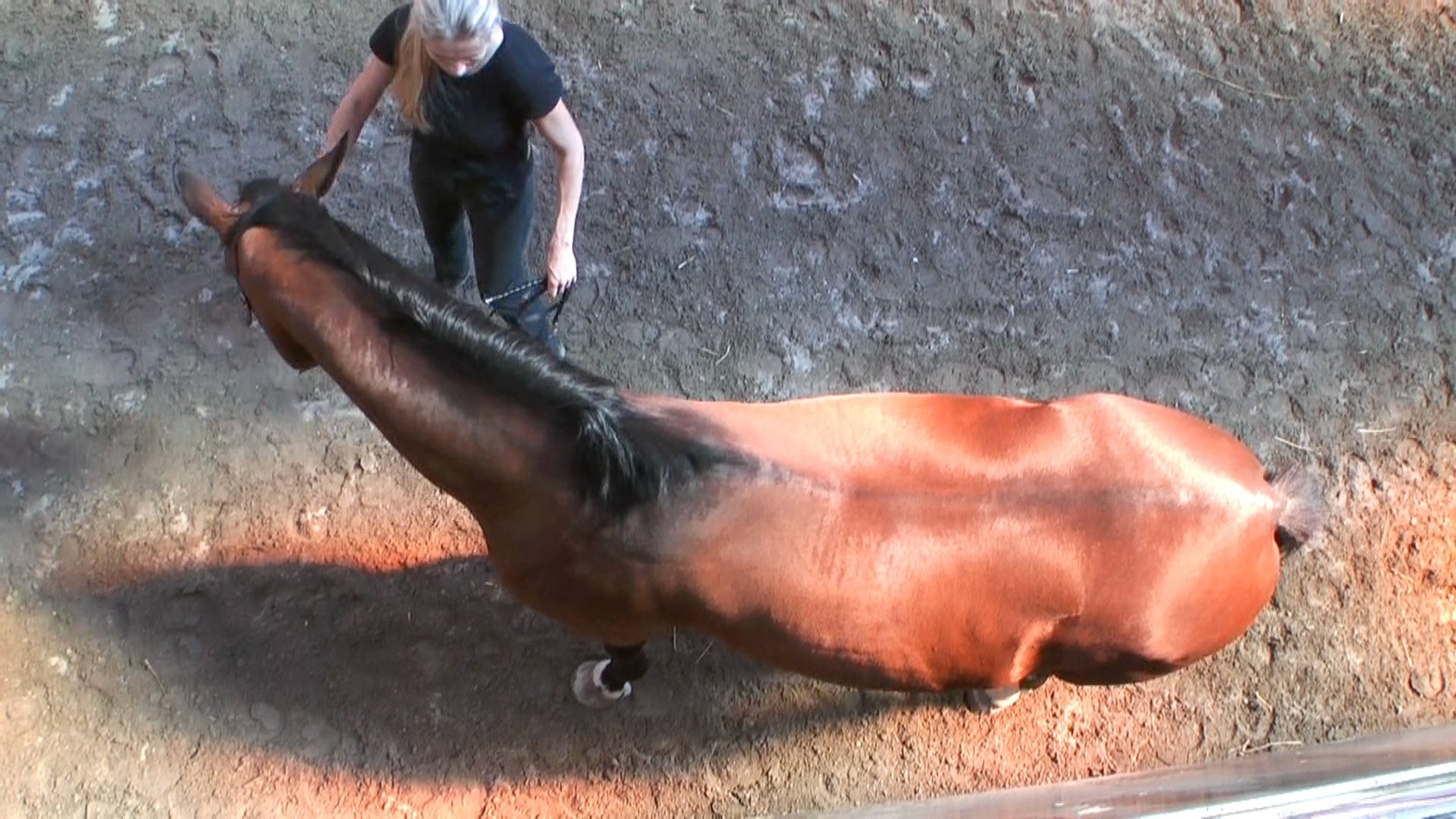 We need a tool so we can be very specific in placing the skull in relation to the spine. And by placing the skull we are able to influence the whole spine, so we can reach the hind legs, which are connected with the spine through the sacro iliac joint. Now the skull is connected with the first vertebrae of the spine - the atlas - and here's a short video so you have an idea what the skull, the atlas, the spine and the sacro iliac joint looks like:
We need a tool so we can be very specific in placing the skull in relation to the spine. And by placing the skull we are able to influence the whole spine, so we can reach the hind legs, which are connected with the spine through the sacro iliac joint. Now the skull is connected with the first vertebrae of the spine - the atlas - and here's a short video so you have an idea what the skull, the atlas, the spine and the sacro iliac joint looks like:  By using proper tack we can be very specific in asking the horse to flex to the left and right with the head (also called 'stelling'), without the horse twisting the head, by keeping the ears level. And we can also ask for neck bending and bending in the body. And with proper stelling and bending we are able to reach the inside hip; it will come slightly forward which is necessary to get to key 3 of ST: the stepping under of the inside hind leg.
By using proper tack we can be very specific in asking the horse to flex to the left and right with the head (also called 'stelling'), without the horse twisting the head, by keeping the ears level. And we can also ask for neck bending and bending in the body. And with proper stelling and bending we are able to reach the inside hip; it will come slightly forward which is necessary to get to key 3 of ST: the stepping under of the inside hind leg.
3. Mouth prevention
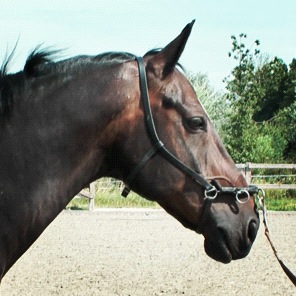 Another reason why we need to be specific in choosing our adequate tool is that the young or crooked horse is not used to bending its body and will constantly try to move with its body straight instead of bended. Therefore we cannot put something in the mouth of the horse when starting with ST. So we need a special tool to teach the horse all gymnastics without disturbing or harming the mouth, and in Straightness Training we prefer a cavesson.
Another reason why we need to be specific in choosing our adequate tool is that the young or crooked horse is not used to bending its body and will constantly try to move with its body straight instead of bended. Therefore we cannot put something in the mouth of the horse when starting with ST. So we need a special tool to teach the horse all gymnastics without disturbing or harming the mouth, and in Straightness Training we prefer a cavesson.
4. Types & Variations
There are several types of cavessons, and a variety is used by people when doing Straightness Training. We have in-depth experience with the types and variants below. And in this article, we'll share the benefits and drawbacks with you, so you get an idea and can make a choice that suits you and your horse best.
4.1. The ST Cavesson
The ST cavesson has been invented to teach the horse to bend, halt, place the head and hindquarters correctly and to make the body and limbs supple and flexible, without harming the mouth. By using an ST cavesson, it is possible to bend the horse laterally through the entire spine, from the first neck vertebra all the way to the tail. This lateral bending is required in all Straightness Training exercises, both during groundwork, longeing, work in hand and riding.  The ST cavesson consists of a metal nose chain wrapped around with leather, which shapes around the nose. Three metal rings are attached onto the noseband. These rings are moveable, which makes it easy to change the rein. A strap around the lower jaw prevents the cheek piece from moving up into the eyes. The leather is supple, feels comfortable in the hand of the rider and fits closely to the head of the horse. The cavesson has been used for centuries to train horses. Grand master François Robichon de la Guérinière (1688 - 1751) writes about the cavesson in his book ''École de Cavalerie''.The Duke of Newcastle and De la Broue (circa 1600) also wrote about the benefits of using the cavesson.
The ST cavesson consists of a metal nose chain wrapped around with leather, which shapes around the nose. Three metal rings are attached onto the noseband. These rings are moveable, which makes it easy to change the rein. A strap around the lower jaw prevents the cheek piece from moving up into the eyes. The leather is supple, feels comfortable in the hand of the rider and fits closely to the head of the horse. The cavesson has been used for centuries to train horses. Grand master François Robichon de la Guérinière (1688 - 1751) writes about the cavesson in his book ''École de Cavalerie''.The Duke of Newcastle and De la Broue (circa 1600) also wrote about the benefits of using the cavesson.
Benefits
- With a ST cavesson your point of connection with the horse's head is from on top of the nose, this will encourage the horse to give the correct stelling (flexion) and bending.
- It fits very well around the horses's nose and it doesn't slip from one side to another.
- The best testament to the value of an ST cavesson is that you can work in a very precise, detailed and refined way when it comes to applying pressure and release.
- in St we strive for 'more with less' we do strive to use as little pressure as possible, and because of this we need a tool that can transform the slightest touch in a very detailed way.
Drawbacks
- Honestly, there is not much downside to using an ST cavesson, if used correctly. Of course there is a metal chain in the noseband, and it shapes perfectly around the nose, which is a huge benefit because you can be much more precise and specific when applying pressure and release. Since we strive for 'more with less' we do strive to use as little pressure as possible, and because of this we need a tool that can transform the slightest touch in a very detailed way. But of course when you start 'jerking around' with this cavesson, it will not do your horse any good. But so will other tools that are used incorrectly. Also with a normal leather halter you can cause harm when you use it with force. Again, it's never the tool, it's always the human behind the tool.
- The ST cavesson is not 'idiot' proof. So when used incorrectly - with too much / too long / to often pressure and without release - this tool can harm the communication and relationship with a horse. Since we strive for teaching a rider HOW to use the cavesson properly in ST and how to master our energy, instead of avoiding the tool, leaving the rider unskilled, there's no big risk involved in using the ST cavesson.
- The cavesson is one size and therefore it doesn't fit very small ponies and huge headed horses, so it doesn't fit a little Falabella pony and it doesn't fit a huge Clydesdale. But it fits all horses in between, so from an Arab to a Swedish Coldblood trotter, from a riding pony to a warmblood horse. In the future we will also produce cavessons in more sizes, so also the littlest and biggest horses on earth can benefit from ST! Click HERE if you would like to order a cavesson in the ST Webshop >>
4.2. ST and a nylon cavesson
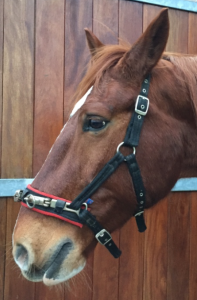
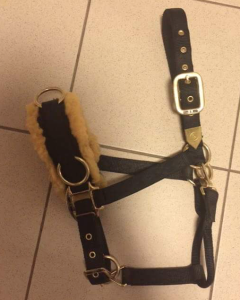
Benefits
- This cavesson is much cheaper than the ST cavesson, therefore a lot of beginner ST trainers are attracted to this cavesson.
- This cavesson is to a certain extent 'idiot proof'.
Drawbacks
- Nylon or webbed cavessons don't sit stable over the horse's nose and can easily be pulled over the nose. Therefore you cannot work in a precise and refined way.
Because of the wide nose band, the pressure is widely spread, therefore you cannot work in a precise and refined way. If you apply specific pressure it will spread widely over the nose.
- Training a horse with this cavesson is like doing 'sign language' with 'mittens'. So it's not easy for the horse to find out what you exactly mean, because it diffuses the clear communication.
4.3. ST and a rope halter
Many Natural Horsemanship and Western riders use rope halters in their training, and they'd like to continue with that tool in doing ST and lateral movements with a horse.
Drawbacks
- The biggest challenge with this tool is that the rope halter is not so precise when practicing the stelling and bending. When the rope is under the chin it has a different action than when the pressure comes from the nose and can, therefore, cause a twist. So with a rope halter you have the chance that you get head tilt as your connection to the horse's head is from below. A very easy way to have a feel yourself is to put your finger under your chin (like you would have a halter on) and pull your head to one side. Your jaw will stick out in the direction you pull. If you put your fingers on your nose and pull your head around your jaw won't stick out and you have a correct stelling.
- To avoid the tilt, you can clip the rope or the rein on the nose band, but this rope or rein can easily slide from one side to the other, which makes your pressure and release actions less precise.
........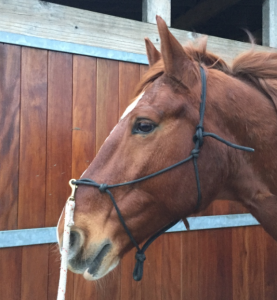
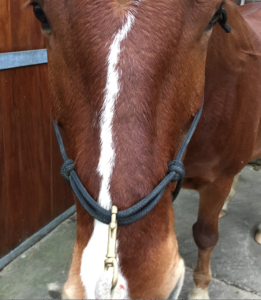
Clipping in the midde
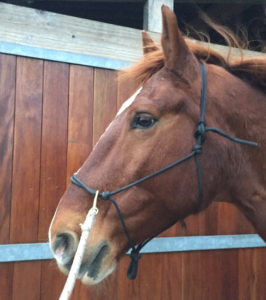
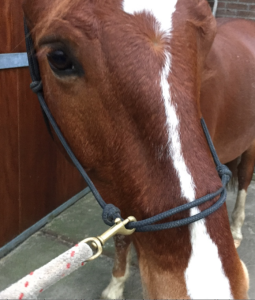 ,.Sliding to the side
,.Sliding to the side
Benefits
- The benefit from using this tool is that your horse is already familiar with this tool.
- Whilst you are waiting for the caveson to arrive, you could put a thin string onto the nose of the halter, and tie it exactly in the middle, then the action will be better when doing groundwork.
- Now when you have an advanced horse that has been trained well in Straightness Training it can be fun to practice the training pillar 'work in hand' , just to compare how it feels to do the exercises with this tool and with the cavesson. With both tools you can create quality in the movements, because you work mainly with your inner picture, inner feeling, body language and so you don't need that much rein aids, but you'll find out for yourself what you prefer:
4.4. ST with a stainless, leather cavesson or Micklem
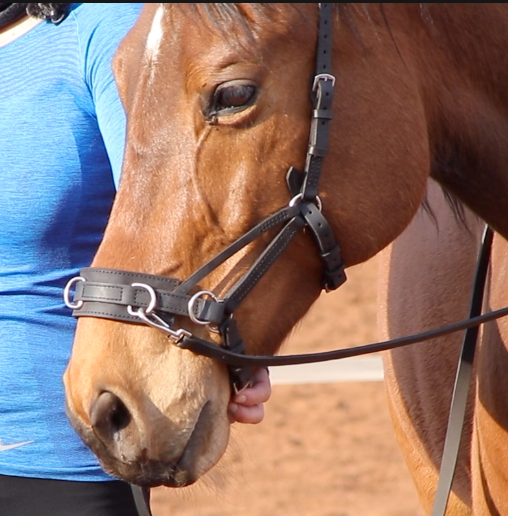
Because of the metal chain in the ST cavesson, many horse lovers are attracted to a cavesson with a leather nose band, or by tools that are designed to not harm any nerves on the horse's head. But remember, it's always the human...
Benefits
- Also this cavesson is more 'idiot proof' than the ST cavesson, because you can apply more pressure without harming the horse.
- It's also a good tool if you want to apply an 'avoidance strategy' so you don't have to refine your pressure/release technique.
Drawbacks
- Leather cavessons work well to a certain extend, but since I want to work in a precise, detailed, and very refined way, I prefer a cavesson with a chain.
- Especially when the noseband is very wide, it diffuses the pressure and therefore it diffuses your message. And when the noseband is also fastened with a lot of space, it will slide and then the message is even more unclear.
- The tool doesn't help you to become a master and artist in the pressure/release technique.
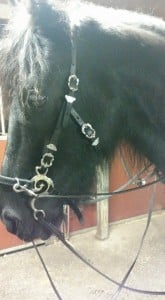 4.5. ST with a cavemore
4.5. ST with a cavemore
A cavemore is a combination of a cavesson and hackamore, and it's mainly used by riders who want to ride bitless on the levels of collection. When we start to bend the haunches to collect the horse, one of the most important things is to keep the horse's topline long and stretched towards the rider's hand.
Benefits
- The leverage of the shanks of the cavemore influences the skull similar to a curb. So with a cavemore you can also ask the horse to continue to search for the rider's hand.
Drawbacks
- The cavemore is more 'idiot proof' as the combo cavesson-curb (click HERE for more info about bits).
4.6. ST with bridle and snaffle
Some riders insist on using a bridle and a snaffle (without a cavesson). And sometimes it's mandatory in competitions to ride with a snaffle.
Benefits
- The benefit from using the bridle and the snaffle is that your horse is already familiar with this tack.
Drawbacks
- Starting ST with a bridle and snaffle can lead to a 'dead mouth'. Because when a crooked horse is not used to bending its body and will constantly try to move with its body straight instead of bended, then we need to correct him constantly in the mouth. But the crookedness is not a mouth problem, it's a muscle problem.
- When you use a double jointed snaffle, there is a great risk that one of the joints squeezes the corner of the mouth when you ask for stelling/bending.
Therefore this option is not recommended. When we educate the horse in the early stages, retaining the sensitivity of the mouth for refinement is one of our highest priorities. But of course if you have to commit to the requirements of competition dressage, feel free to decide to use a snaffle. But in ST we use the dressage for the horse and not the horse for the dressage, so we use the dressage and the tools for the benefit of the horse, and not the horse to fit the dressage and the dressage competition world.
4.7. Other bitless tack
Now there's many more bitless tack our there in the world, like bosals, hackamores, side pulls, Dually halters, cross rope halters, Dr. Cook bridles, and many more, and before you start to decide WHAT tool, always start with WHY and then you can make a proper decision.
5. Rope, leather, or elastic reins?
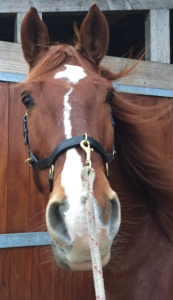
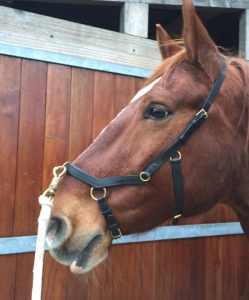
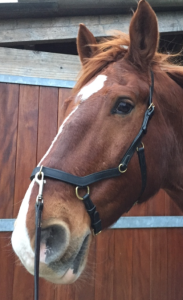
In groundwork and longeing you can choose to work with a rope or with a rein or line.
- I prefer a rein or a line, since a rope is heavier and thicker than a rein. And with a heavy or think rope, tiny little details of your half halt cannot always come through properly.
- Especially in longeing the rope weighs even more, because of the center of gravity. And this might hinder the self carriage or your horse and it might hinder your application of tiny little half halts.
- Also a big buckle might be in the way when you want to apply tiny little half halts with your hand close to the nose.
- Elastic reins are definitely not an option, because your precise pressure and refined half halts will get lost along the way.
6. Where can I find more info about the ST cavesson?
Click here for more info about the ST cavesson >>
7. Where to buy an ST cavesson?
Check out this webshop: 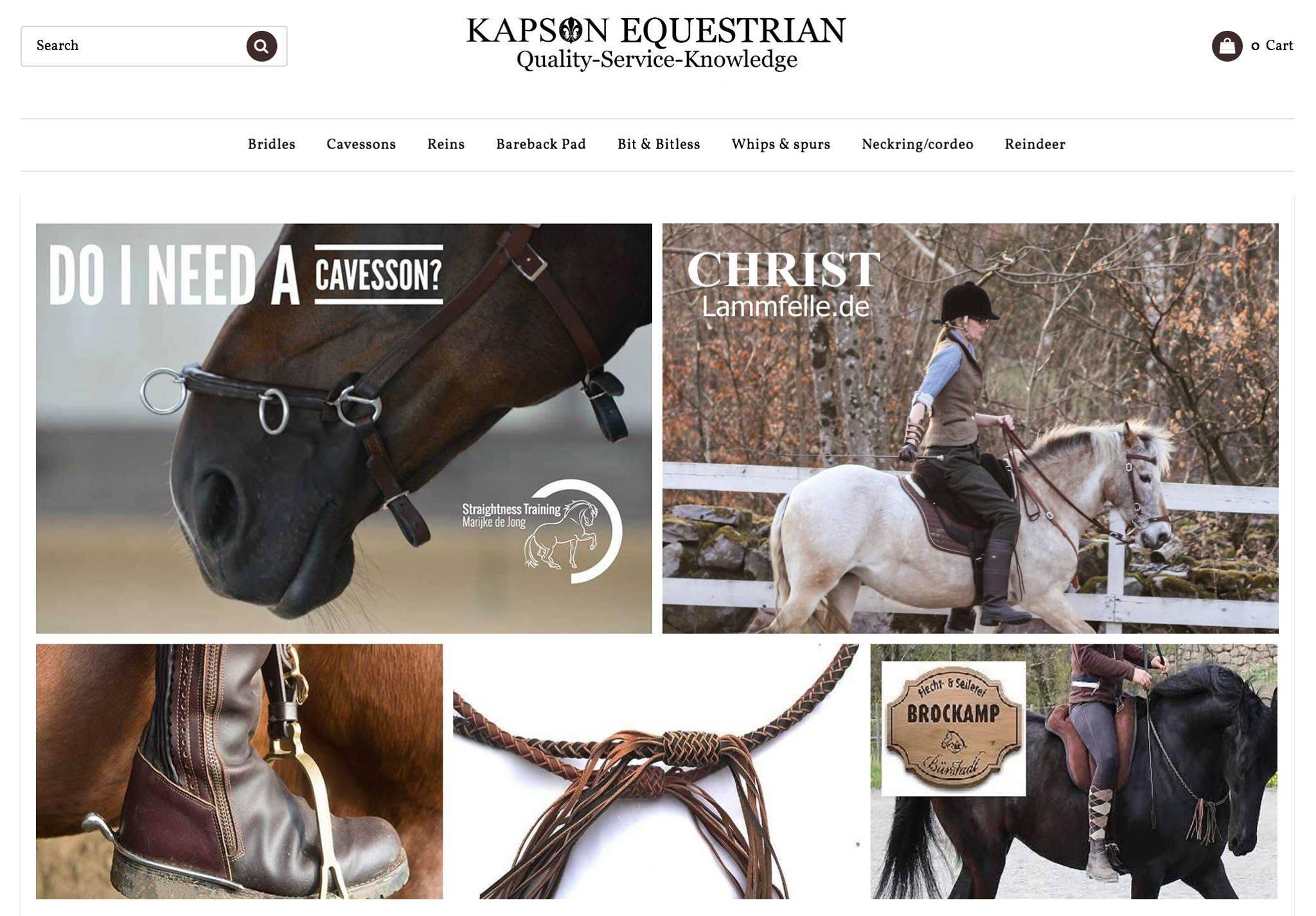 ▶︎ https://www.kapsonequestrian.com/en/ And we recommend this specific type >>
▶︎ https://www.kapsonequestrian.com/en/ And we recommend this specific type >>
Enjoy My Free Training
Jump on over to my free training were you get a three-step process for implementing Straightness Training in your training sessions right now. Watch two videos and download your free eBook which will help you put the information into action right away: 


